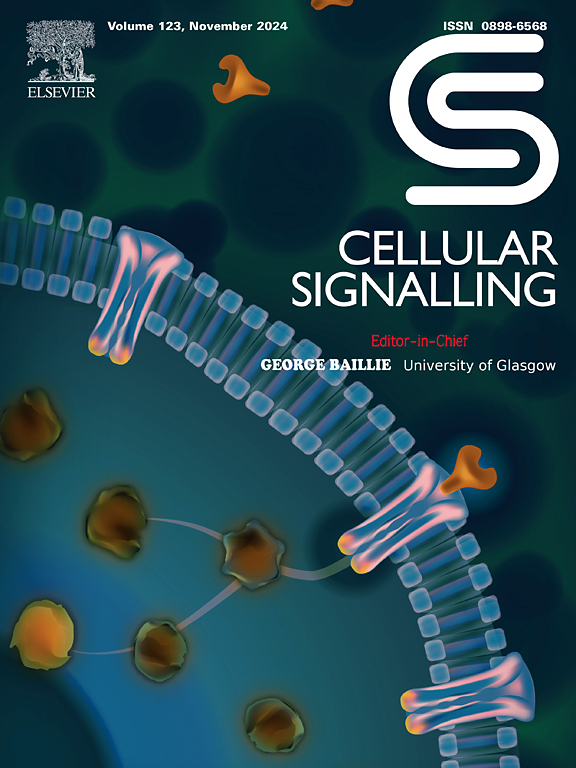Characterization of functionally relevant G protein-coupled receptors in endometriotic epithelial cells
IF 4.4
2区 生物学
Q2 CELL BIOLOGY
引用次数: 0
Abstract
Endometriosis is a chronic inflammatory disease characterized by the invasion of endometrial cells outside the uterine cavity. Current treatments for the disease, whose typical symptoms are pain and infertility, are unsatisfactory, relying on the surgical removal of the lesions and hormonal therapies with high symptom relapse and collateral effects, respectively. The aim of the present study was to exploit the rationale for G protein-coupled receptors (GPCRs) as non-hormonal therapeutic targets for this disease. To this end, human endometriotic epithelial cells 12Z were employed to characterize GPCR-mediated increases in intracellular Ca2+ concentrations ([Ca2+]i) using fluo-4, and cell invasion was measured using Boyden chamber assays. The results showed that the GPCR ligands oxytocin, bradykinin, histamine, lysophosphatidic acid, and sphingosine 1-phosphate (S1P) efficiently increased [Ca2+]i and induced cell invasion in endometriotic cells. In contrast, neuropeptide S, previously identified as a pro-invasive mediator, did not increase [Ca2+]i in 12Z cells. Notably, pretreatment with pertussis toxin significantly reduced S1P-dependent [Ca2+]i increase and cell invasion, highlighting the involvement of Gi-mediated signaling. Employing specific agonists and/or antagonists of S1P receptor isoforms, we demonstrated that S1P1/S1P3/S1P5, but not S1P2/S1P4 mediated the [Ca2+]i increases in this cellular model. Moreover, activation of S1P1/S1P4/S1P5, but not S1P2/S1P3, efficiently stimulated cell invasion.
Taken together, we identified several GPCRs that are functionally relevant in human endometriotic epithelial cells and may potentially serve as targets for non-hormonal therapy of endometriosis.
子宫内膜异位症上皮细胞中功能相关G蛋白偶联受体的表征
子宫内膜异位症是一种慢性炎症性疾病,其特征是子宫内膜细胞侵入子宫腔外。该疾病的典型症状是疼痛和不孕,目前的治疗方法令人不满意,分别依赖于手术切除病变和高症状复发和附带效应的激素治疗。本研究的目的是利用G蛋白偶联受体(gpcr)作为这种疾病的非激素治疗靶点的基本原理。为此,人类子宫内膜异位症上皮细胞12Z使用fluo-4表征gpcr介导的细胞内Ca2+浓度([Ca2+]i)的增加,并使用Boyden室测定细胞侵袭。结果表明,GPCR配体催产素、缓激肽、组胺、溶血磷脂酸和鞘磷脂1-磷酸(S1P)能有效增加子宫内膜异位症细胞中的[Ca2+]i,诱导细胞侵袭。相比之下,神经肽S,以前被认为是一种促进侵袭的介质,在12Z细胞中没有增加[Ca2+]i。值得注意的是,百日咳毒素预处理显著降低了s1p依赖性[Ca2+]i的增加和细胞侵袭,突出了gi介导的信号通路的参与。使用S1P受体同种异构体的特异性激动剂和/或拮抗剂,我们证明了S1P1/S1P3/S1P5,而不是S1P2/S1P4介导了细胞模型中[Ca2+]i的增加。此外,激活S1P1/S1P4/S1P5,而不是S1P2/S1P3,有效地刺激细胞侵袭。综上所述,我们确定了几种与人类子宫内膜异位症上皮细胞功能相关的gpcr,它们可能作为子宫内膜异位症非激素治疗的潜在靶点。
本文章由计算机程序翻译,如有差异,请以英文原文为准。
求助全文
约1分钟内获得全文
求助全文
来源期刊

Cellular signalling
生物-细胞生物学
CiteScore
8.40
自引率
0.00%
发文量
250
审稿时长
27 days
期刊介绍:
Cellular Signalling publishes original research describing fundamental and clinical findings on the mechanisms, actions and structural components of cellular signalling systems in vitro and in vivo.
Cellular Signalling aims at full length research papers defining signalling systems ranging from microorganisms to cells, tissues and higher organisms.
 求助内容:
求助内容: 应助结果提醒方式:
应助结果提醒方式:


